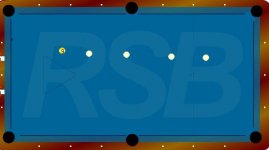I've been debating in the aiming thread and I believe there is an important reason for the confusion in aiming systems. The fact is, most you players cannot aim well.
Simple proof, go line up a dead straight shot from baulk line on a snooker table and pot balls from the center spot into the corner. Maybe a few of the pros here could get 25 out of 50, but I guess the Houliites would be lucky to make 15 out of fifty.
At my best I could average 35 out 50 and the top pro snooker players can average around 40-45 out of 50.
I'm not making this point to be arrogant, but because I believe snooker players can aim more accurately than pool players...a fair assumption right?
The reason I bring this up, is to make a point about aiming vs determining angle. Even the very accurate pro snooker players can see the exact aiming point required, but struggle to hit this. Most of their misses come from poor alignment, not poor angle judgement. They don't miss much, but when they do, 80% of the time it is an alignment problem, not an angle problem.
So, on to the aiming systems being promulgated here!
All are based on the assumption of some kind of aiming point, and some way of manouvering from this point to determing or manufacture the correct potting angle.
I propose that judging the angle is not nearly as hard as actually aligning to the point of aim that is being suggested. That if you could aim accurately you would quickly learn o hit thinner or thicker to determine the required potting angle.
Now, to make a point, look at the diagram below and think about where the 9-ball would go to, based on the trajectory of the cue ball that is shown moving toward it. Will it hit the black mark or left or right of it?
Simple proof, go line up a dead straight shot from baulk line on a snooker table and pot balls from the center spot into the corner. Maybe a few of the pros here could get 25 out of 50, but I guess the Houliites would be lucky to make 15 out of fifty.
At my best I could average 35 out 50 and the top pro snooker players can average around 40-45 out of 50.
I'm not making this point to be arrogant, but because I believe snooker players can aim more accurately than pool players...a fair assumption right?
The reason I bring this up, is to make a point about aiming vs determining angle. Even the very accurate pro snooker players can see the exact aiming point required, but struggle to hit this. Most of their misses come from poor alignment, not poor angle judgement. They don't miss much, but when they do, 80% of the time it is an alignment problem, not an angle problem.
So, on to the aiming systems being promulgated here!
All are based on the assumption of some kind of aiming point, and some way of manouvering from this point to determing or manufacture the correct potting angle.
I propose that judging the angle is not nearly as hard as actually aligning to the point of aim that is being suggested. That if you could aim accurately you would quickly learn o hit thinner or thicker to determine the required potting angle.
Now, to make a point, look at the diagram below and think about where the 9-ball would go to, based on the trajectory of the cue ball that is shown moving toward it. Will it hit the black mark or left or right of it?
